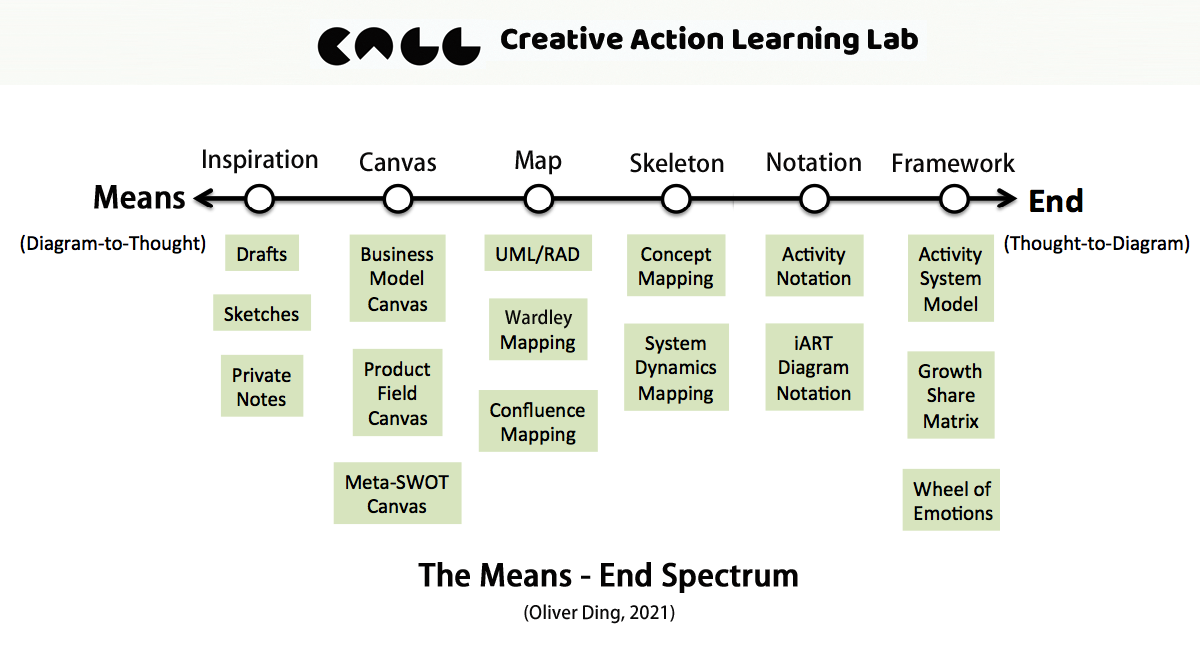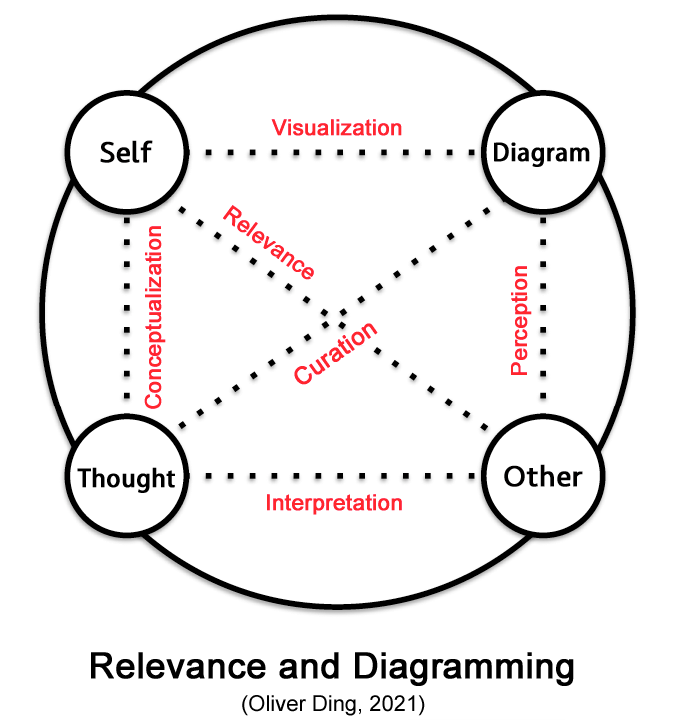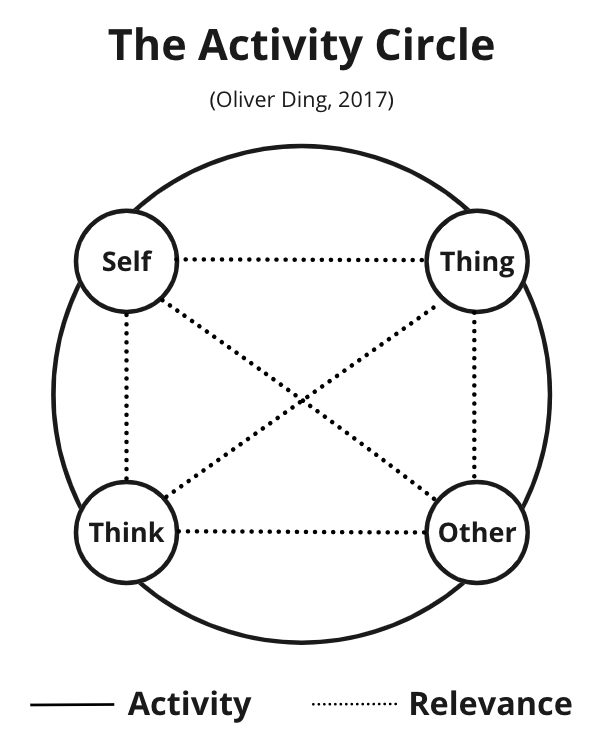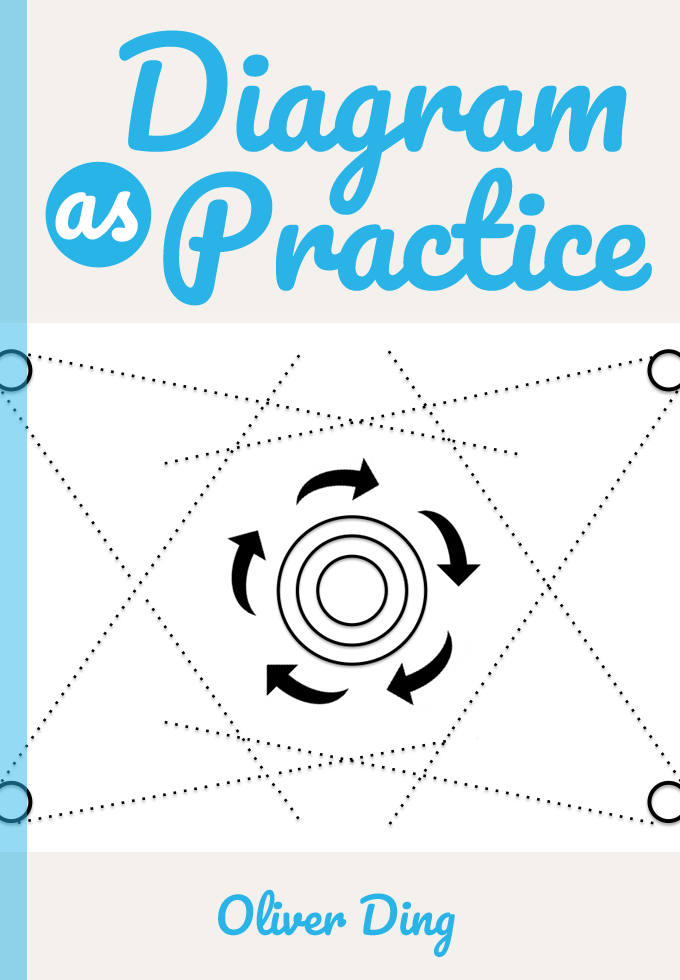Diagramming as Activity

Diagrams are one of my favorite practices. I love to dwell in thought with diagramming. I even wrote a 108-page thesis that develops a theory about diagrams and diagramming in 2018. I consider two groups of ideas for my theory about diagrams. The first group is “meta-diagram, diagram, and diagram system” and the second group is “diagramming as an activity of knowing, theorizing, and reflecting”.
The notion of “diagramming as an activity of knowing, theorizing and reflecting” adopts an Activity view to understand Diagramming as a Social Practice. In other words, it is “becoming.” That means we can use diagrams as a tool for our thinking. We don’t need to consider all diagrams as final outcomes.
I have discussed this topic in a previous article: Method 101: Diagramming as Theorizing. As Engeström mentioned, “I use the graphic models in series of successive variations, not just as singular representations…With the help of such variations, I try to demonstrate how the models can depict movement and change. The reader is invited to formulate and test his own variations.” (1987, p.47) We should remember that a diagram is not a dogma but a guide to action.
The Means-End Spectrum
The Means-End issue is a complicated issue in the literature of Activity Theory and Vygotsky’s Cultural-historical theory of psychology because scholars have different interpretations of Vygotsky’s ideas. As mentioned above, the mediated action v.s. mediating activities debate is an example. A second example might be Newman and Holzman’s ideas v.s. Bruner’s ideas. According to Newman and Holzman, “Vygotsky’s tool-and-result method is purposeful in the Marxian sense, not, contrary to Bruner’s formulation, in the instrumentalist sense. Vygotsky’s rejection of the causal and/or functional methodological notion of tool or instrument for a purpose or result in favor of the dialectical notion of tool-and-result in the study of human psychology is new and revolutionary.” (1993, p.40)
From the perspective of Activity Theory, I consider the Means v.s. End issue within concrete activities. For a particular activity, a diagram might be an end, I call it Thought-to-Diagram. For another particular activity, the same diagram might be a means, I call it Diagram-to-Thought. If we combine these two situations together, we can develop a Means-End Spectrum and use it to present various instrumental values of diagrams.

The above diagram offers a spectrum with six types of diagrams. The left side refers to Means (Diagram-to-Thought) and it stands for a weak ontological position of diagrams. We don’t have to require a perfect form of diagrams if we use them as means for our thinking since we don’t make diagrams as final products. The right side refers to End (Thought-to-Diagram) and it requires a strong ontological position of diagrams. In order to make diagrams as final products for others to use, we have to work hard to produce ideal diagrams.
Based on the spectrum of ontological positions of diagrams, I identify six types of diagrams: Inspiration, Canvas, Map, Skeleton, Notation, and Framework. The weakest position is Inspiration which refers to drafts, sketches, private notes, etc. The most strong position is Framework which refers to formal knowledge models.
- Framework: I also call this type of diagrams Knowledge Diagram. If you read my articles about diagrams, you probably notice that I used the term Diagrams interchangeably with Knowledge Frameworks. For example, Activity System Model is a framework of Activity Theory, it uses a triangle as the visual layout of its diagram. Growth-Share Matrix is a portfolio management framework that helps companies decide how to prioritize their different businesses by their degree of profitability. The matrix was created in 1968 by BCG’s founder Bruce Henderson. Wheel of Emotions is a model of emotion classification, it was developed by the psychologist Robert Plutchik in 1980.
- Notation: It means the process of adding notes to a knowledge diagram. Sometimes, the notation will turn a basic model into an expanded model. The term “Diagram Notation” is inspired by Daisy Mwanza’s Activity Notation which is one of four methodological tools of the Activity-Oriented Design Method (AODM). I also made iART Diagram Notation and expanded the basic model of the iART framework into an expanded model. You can find more details here.
- Skeleton: this type of diagram doesn’t have a solid framework, but it offers a systematic way of structure for organizing concepts. For example, Concept Mapping is a method developed by Joseph Donald Novak in the 1970s. The Concept Mapping method doesn’t provide a particular knowledge framework, but it guides people to build their own conceptual frameworks. The System Dynamics Mapping refers to a series of system thinking archetypes that were developed by Senge (1990) and Pegasus Communications (1989–1996). One of these archetypes is the Accidental Adversaries archetype.
- Map: this type of diagram is used as a mapping platform for modeling or sense-making. Sometimes they also offer a specific method of conceptualization. For example, UML/RAD is used for modeling processes in the field of Software Engineering and Information Systems. UML stands for Unified Modelling Language that includes Activity Diagrams as one of its techniques. RAD stands for Role Activity Diagrams which is a method of modeling processes too. Wardley Mapping is a method for sense-making in the field of business strategy. Confluence Mapping was introduced by Cynthia Kurtz in her 2021 book Confluence: Tools for Thinking about How Organized Plans and Self-organized Patterns Flow Together.
- Canvas: What is the major difference between a framework and a canvas? A simple answer is that the former focuses on expressing the relationship between several concepts while the latter primarily offers spaces for posting notes which can be considered as data about concepts. For example, Business Model Canvas may be the first business knowledge canvas, Product Field Canvas is a sense-making tool for building products, Meta-SWOT Canvas turns classic SWOT into a dynamic and action-driven strategic tool.
- Inspiration: drafts, sketches, and private notes, these are used for recording inspirations in the process of creative thinking. They may be the seed of other types of diagrams.
The above discussion offers a rough typology of diagrams. However, the value of the Means-End Spectrum is highlighting the dynamics of ontological positions of diagrams because it matches the dynamics of thoughts.
Modeling Diagramming
The Means-End Spectrum is a module of an integrated framework for modeling Diagramming as Practice. In Dec 2021, I adopted four perspectives to develop a framework for researching diagramming. One of these four perspectives is Activity Theory, especially the “Mediating Instrument”.
Activity Theory or the “Cultural-historical activity theory (CHAT)” is an interdisciplinary philosophical framework for studying both individual and social aspects of human behavior. You can find more details about it in The Landscape of Activity Theory and CHAT.
The logical starting point of Activity Theory is Lev Vygotsky’s Mediated Action. Vygotsky claimed that human action and psychological functions are mediated by tools which refer to technical tools that work on objects and psychological tools that mediate the mind and environment. This article doesn’t want to discuss the historical development of Activity Theory, I just use “Mediating Instrument” to name a practical perspective that is inspired by Vygotsky’s original idea that human action and psychological functions are mediated by tools. For the present discussion, Diagrams are considered a "Mediating Instrument".
Researchers have been adopting Activity Theory as a descriptional and orientational framework for analysis and evaluation in a variety of empirical studies. Some researchers also developed practical tools for connecting Activity Theory and empirical studies, for example, the Activity Checklist (Kaptelinin, Nardi, and Macaulay 1999).
According to Kaptelinin and Nardi (2006), there are five basic principles of Activity Theory:
- Object-orientedness
- Tool mediation
- Internalization — externalization
- Hierarchical structure of activity, and
- Development
The Activity Checklist applies the principle of tool mediation with other principles and develops four sections of the checklist in order to design and evaluate technologies and tools.
- Means and ends: the extent to which the technology facilitates and constrains attaining users’ goals.
- Environment: the integration of target technology with other tools and resources.
- Learning, cognition, and articulation: internal versus external components of activity and support of their mutual transformations.
- Development: the transformation of components over time.
The Activity Checklist is developed for HCI (Human-computer interaction) researchers and designers. For the present discussion, we don’t have to directly apply it. However, we can learn something from their approach of connecting basic principles and practical tasks.
Inspired by the Activity Checklist, I adopt the "Mediating Instrument" perspective to discuss the diagramming practice and highlight four essential issues for the present discussion. See the diagram below.

The above diagram shows four issues. Some issues are inspired by Activity Theory, other issues are defined by the “Diagram — Thought” curating practice.
- Means v.s. End: This issue is directly adopted from Activity Theory. However, I developed a Means-End Spectrum in order to present various instrumental values of diagrams. See the above discussion.
- Past v.s. Present: This issue is inspired by the principle of Development, which is an important principle of Activity Theory. My framework focuses on the evolution of thoughts and diagrams.
- Part v.s. Whole: This issue is inspired by the principle of the Hierarchical structure of activity, which considers a three-level hierarchy: operation — action — activity. I discuss diagram-in-use as a whole and a particular action of using a diagram.
- Ambiguity v.s. Precision: This issue is inspired by the principle of Object-orientedness, which means any activity has its motive and goals which point to a final outcome. I consider the process of thought to be an activity that aims to transform ambiguous ideas into precise ideas.
The above four issues are discovered from the D as Diagramming project. Since I just conducted a few case studies, these issues are not a complete list for studying knowledge diagrams. I considered them a good starting point.
You can find more details about these four issues in the following two articles:
- D as Diagramming: An Integrated Framework for Studying Knowledge Diagrams (Part 3A)
- D as Diagramming: An Integrated Framework for Studying Knowledge Diagrams (Part 3B)
Relevance and Diagramming
An Activity is a Social Practice. My framework understands Diagramming as a social practice of social life.
I used the diagram below to discuss the "Self - Other" relevance and the "Diagram - Thought" activity. This diagram is very simple, but it can be used to discuss the complexity of diagramming and social life.

I also add several red words to describe several types of relations between entities. The “Self — Diagram” relation refers to Visualization while the “Self — Thought” relation refers to Conceptualization. We can use Curation to understand the “Diagram — Thought” relation because the “Visualization — Conceptualization” fit is a process of curation.
The “Self — Other” relation refers to the idea of Relevance.
The “Other — Diagram” relation refers to the idea of Perception. Since diagrams are visual graphics, perception is important for Others to understand the meanings of diagrams.
The “Other — Thought” relation refers to the idea of Interpretation which refers to a dynamic interactive process between Self and Other. Others may not understand the meanings of a diagram, they could ask the author of the diagram. Others also could share a diagram with their friends and other people, they could share their own understanding of the diagram too.
You can find more details about these issues in the following two articles:
- D as Diagramming: An Integrated Framework for Studying Knowledge Diagrams (Part 1)
- D as Diagramming: An Integrated Framework for Studying Knowledge Diagrams (Part 2)
The Activity Circle
The above "Relevance and Diagramming" framework is an application of the "Activity Circle" model. See the diagram below. It is perfect for discussing a special object which has double properties: material property and mental property. This idea was inspired by cultural-historical psychologist Lev Vygotsky’s two types of mediating tools: technological tools and psychological tools.

I used several names for the above model. For example, It was called "Relevance of Zone" in 2021. Finally, I decided to use “Activity Circle” to it in July 2022. However, I am not sure if it is appropriate to propose the term “Activity Circle” as a new concept for the field of Activity Theory.
Several months ago, I found Benny Karpatschof’s 2000 book Human Activity: Contributions to the Anthropological Sciences from a Perspective of Activity Theory. Though I have read many books and papers about Activity Theory, Karpatschof’s theoretical approach opened a new door for me. The most important idea of his account is to bring Sign/Meaning/Concept back to Activity Theory.

According to Benny Karpatschof, “…the full context of activity in which the category of meaning (“ideas”) is situated can be seen. In the feedback circle, there is an operational as well as a referential mediation. I call the referential side meaning production. The other side is the category of object production, where production is to be understood in a broad sense, including interventions that only modified the object. If we now consider the relation between meaning and object production in human activity, there are 3 logical types: 1. The object-reflecting meaning production, 2. The symmetric interplay of objects and meaning production, 3. The concept based object production. ”(2000, p.248)
Benny Karpatchof’s approach to human activity considers both Tool and Sign. This approach echoes Lev Vygotsky’s two types of mediating tools. This is the reason that I pay attention to Benny Karoatchof’s 2000 book.
The difference between Benny Karpatschof’s model of Human Activity and my model of Activity Circle is the former only talks about the individual—object interaction and the latter considers the self—other relevance.
Diagramming as Practice (v1, draft)
In Dec 2021, I developed an integrated framework for researching knowledge diagrams. The outcome is a book titled Diagramming as Practice (v1, draft).

You can find more articles in the following links:
- The Diagramming as Practice Framework (Dec 16, 2021)
- The Mind as Play Metaphor (Nov 9, 13 min read)
- An Integrated Framework for Studying Knowledge Diagrams — Part 4A (Dec 9, 16 min read)
- An Integrated Framework for Studying Knowledge Diagrams — Part 4B (Dec 11, 14 min read)
